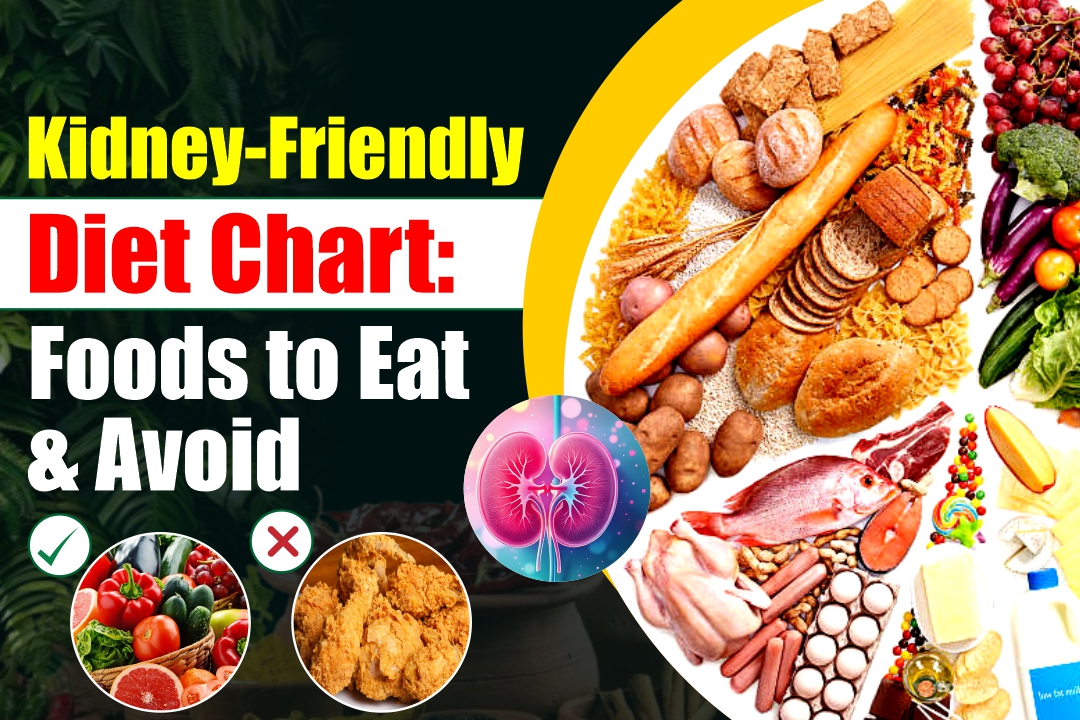
Kidney-Friendly Diet Chart: Foods to Eat & Avoid
If you’ve recently been told that your kidneys aren’t working as well as they should or you’re simply trying to take better care of your body, then you’ve probably heard about the importance of following a kidney-friendly diet. To clarify, soaking up the information surrounding food can hugely impact kidney health. However, food is food, and it can sometimes be difficult to determine what foods are beneficial and what foods might be more harmful than helpful.
Don’t fret; this article is going to provide kidney health information in an informational and human way. We will explore together what the term paramount kidneys means, what foods are beneficial and kidney-supportive, what foods should be limited or avoided, and how to make food choices enjoyable (not punishment-like) even with chronic kidney disease (CKD) or as your kidneys continue to perform at their peak.
Why Does a Kidney-Friendly Diet Matter?
Your kidneys are small, but they’re mighty. They filter waste and extra fluid from your blood, help regulate blood pressure, balance electrolytes, and even produce hormones that support red blood cell production. When they’re not working properly, waste and toxins can build up in your body, and that’s when things can get serious.
A kidney-friendly diet helps reduce that burden on your kidneys. It keeps certain nutrients in check (like sodium, potassium, and phosphorus), supports overall health, and may even help slow the progression of kidney disease.
Key Nutrients to Watch
When you’re trying to eat for your kidneys, the main nutrients you need to keep an eye on include:
- Sodium: Too much sodium can increase blood pressure and cause fluid retention, both of which strain the kidneys.
- Potassium: When your kidneys aren't working well, potassium can build up in the blood and affect your heart rhythm.
- Phosphorus: Excess phosphorus can weaken bones and cause calcium imbalances.
- Protein: Important for muscle repair and overall health, but too much can overwork the kidneys, especially if they’re already struggling.
Foods to Eat on a Kidney-Friendly Diet
Let’s start with the good news: there are plenty of delicious foods you can enjoy that are naturally kind to your kidneys. You won’t have to sacrifice flavor, texture, or variety. Let’s check out an ideal kidney patient diet chart in detail.
1. Low-Sodium Foods
- Fresh fruits and veggies – Think apples, berries, grapes, cabbage, cauliflower, cucumbers.
- Herbs and spices – Garlic, basil, oregano, and rosemary are great for flavoring without salt.
- Unsalted nuts and seeds (in moderation) – Almonds, flaxseeds.
- Home-cooked meals – You control the ingredients and avoid hidden salt in processed foods.
2. Low-Potassium Options
- Apples, grapes, pineapple, and berries
- Cauliflower, green beans, cucumbers, lettuce, onions
- White rice and pasta – Lower in potassium compared to whole grains, which are healthier in general, but higher in potassium.
Pro Tip: Soaking and double-boiling vegetables can reduce their potassium content.
3. Low-Phosphorus Foods
- Rice milk (not enriched)
- White bread (in moderation)
- Corn and rice cereals
- Light-colored sodas (like ginger ale or lemon-lime) instead of colas, which have added phosphates
4. Moderate-Protein Foods
If you're not on dialysis, you'll usually need to limit protein intake a bit. But don’t worry; you don’t have to cut it out entirely.
- Egg whites
- Lean cuts of chicken or turkey (skinless)
- Fish like tilapia or cod
- Tofu and plant-based proteins (in moderation)
If you are on dialysis, your protein needs might go up, so always check with your doctor or dietitian to get the right balance.
Foods to Limit or Avoid
Okay, now the slightly less fun part, but knowledge is power, right? These are the foods that can be a bit rough on your kidneys, especially if you're already dealing with CKD.
1. High-Sodium Foods
- Processed meats like bacon, sausage, and deli meats
- Canned soups and frozen dinners
- Fast food and takeout
- Pickles, chips, salty snacks
Sodium can sneak into your diet easily, so reading labels is key. Aim for less than 2,300 mg of sodium per day or even less, depending on your doctor's advice.
2. High-Potassium Foods
- Bananas, oranges, melons, avocados
- Potatoes, tomatoes, spinach, sweet potatoes
- Beans and lentils
- Dried fruits and fruit juices
It’s all about balance here; some of these foods are super healthy but may need to be limited or portioned carefully if your potassium levels are high.
3. High-Phosphorus Foods
- Dairy products like cheese, milk, and yogurt
- Nuts and seeds
- Cola and dark-colored sodas
- Processed foods with “phos” ingredients (like sodium phosphate or calcium phosphate)
Excess phosphorus can start pulling calcium out of your bones, making them weaker. So, it’s worth being mindful of this one.
4. Too Much Protein
If you’re not on dialysis and your doctor has recommended a lower-protein diet, it’s wise to scale back on:
- Red meat
- Full-fat dairy
- Protein powders or shakes
Tips for Making Kidney-Friendly Eating Easier
Let’s be honest; changing how you eat can feel overwhelming at first. But with a few small adjustments, it becomes second nature. Here are a few practical tips:
- Cook more at home. Even simple meals made from scratch can help you control sodium, phosphorus, and potassium levels.
- Use herbs and spices instead of salt for flavor.
- Rinse canned beans and veggies to reduce sodium.
- Work with a renal dietitian. They’ll help tailor your diet to your specific lab results and health needs.
- Meal prep and plan. Having kidney-friendly snacks and meals on hand makes it easier to stick to your goals.
Don’t Forget to Hydrate Wisely!
Fluid needs vary a lot depending on your stage of kidney disease. Some people need to limit fluids to avoid swelling or high blood pressure, while others need to stay well-hydrated. If you're unsure, talk to your healthcare provider. And when in doubt, stick to water; it’s usually the safest bet.
Ayurveda and Kidney Health
If you’re interested in a more holistic or Ayurvedic approach, some gentle herbs and practices support kidney wellness:
- Punarnava (Boerhavia diffusa) – Known in Ayurveda for reducing water retention and supporting kidney detox.
- Varun (Crataeva nurvala) – Traditionally used to support urinary health and reduce kidney stone risk.
- Gokshura (Tribulus terrestris) – Helps maintain urinary tract balance and promotes kidney function.
Always consult a qualified Ayurvedic practitioner or doctor before starting herbal supplements, especially if you’re on medications or dealing with advanced kidney issues.
Final Thoughts
A kidney-friendly diet isn’t about deprivation; it’s about choosing foods that work with your body instead of against it. Once you learn what your kidneys need (and what they don’t), you’ll find that nourishing yourself can still be delicious, fulfilling, and even fun.
Remember, everyone’s body is a little different. Your diet should reflect your specific needs, lab results, and lifestyle. So, use this kidney-friendly food chart as a starting point, not a one-size-fits-all rulebook. Talk to your healthcare provider or a dietitian if you’re ever unsure. Your kidneys are worth taking care of, one meal at a time

